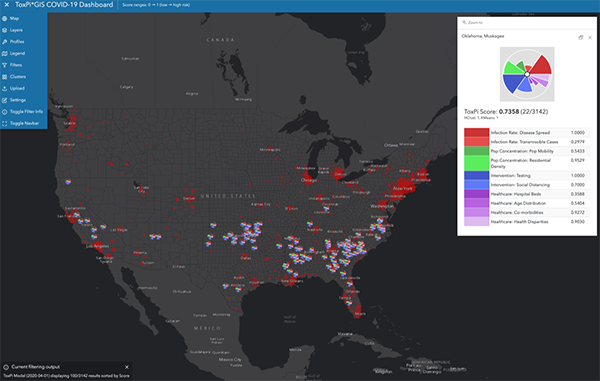Texas A&M, NC State Researchers Develop Online Tool For COVID-19 Risk Assessment
Story by Aubrey Bloom, CVMBS Communications

COLLEGE STATION, April 2, 2020—The COVID-19 pandemic is a global crisis, and government and health care organizations around the world are generating vast amounts of data and models to help inform decisions. However, the majority of impactful decisions on how to handle the crisis are made at the local level, where consistent access and analysis of the data and models can be challenging.
To help solve this issue, a team of researchers from Texas A&M University and North Carolina State University have created an online dashboard, the COVID-19 Pandemic Vulnerability Index (PVI), located at https://toxpi.org/covid-19/map/, to assist local, state, and federal authorities in making decisions about “hot-spots” in COVID-19.
“The response from the scientific community to the COVID-19 pandemic has been enormous and the information that becomes available on different aspects of the disease spread are now available and useful,” said Dr. Ivan Rusyn, director of the Texas A&M Superfund Research Center (SRC) and a university professor in the College of Veterinary Medicine & Biomedical Sciences’ (CVM) Department of Veterinary Integrative Biosciences (VIBS).
Where the COVID-19 PVI Dashboard is different from other attempts to synthesize data for local leaders and the public is that it gives each county a concise “vulnerability scorecard,” which integrates multiple vulnerability indicators related to infection status, mitigation efforts, and pandemic-related vulnerabilities. The team adapted the web-based, decision-support dashboard ToxPi*GIS for the COVID-19 response.
Globally, there is a general road map for the steps in addressing the pandemic, and in the United States, everyone is still at the first step—trying to reduce the spread of the virus through social distancing. However, it can be difficult for localities to understand how such interventions are reducing their vulnerability to continued infections.
Additionally, the time will eventually come to start gradually easing restrictions. But deciding when and where to begin that process is going to be very difficult. State and local leaders will have to closely monitor for disease resurgence while considering the capacity of their local healthcare system.
“Our approach is to integrate these complex data and to communicate the results through easy to understand county-level scorecard,” Rusyn said.
For state leaders, the dashboard can help identify current and, more importantly, potential “hot spots,” which will assist in prioritizing resources.
“The main limitation of most of the online maps currently available is that they are looking in the rear-view mirror, especially due to the long incubation period of COVID-19,” said VIBS professor Weihsueh Chiu, another member of the team. “We aim to fill this gap by developing a vulnerability index to identify potential future hot spots and, thus, help decision-makers initiate, intensify, or relax interventions as appropriate.”
The team is seeking input from local officials and experts to continue to refine the dashboard and its functionality in order to best support decision-making.
“Moreover, all of our software and results are fully open source and transparent,” added Professor Chiu, “and we invite outside scrutiny to help us make rapid updates and improvements.”
The ToxPi*GIS COVID-19 dashboard was adapted from a recently released tool called HGBEnviroScreen—developed by Chiu, Drs. David Reif and Skylar Marvel, both from North Carolina State University in Raleigh, NC, as part of Texas A&M Superfund Research Center—to serve the Houston-Galveston-Brazoria (HGB) region in integrating and visualizing national and local data on environmental health to address regional concerns.
###
For more information about the Texas A&M College of Veterinary Medicine & Biomedical Sciences, please visit our website at vetmed.tamu.edu or join us on Facebook, Instagram, and Twitter.
Contact Information: Jennifer Gauntt, Director of Communications, Texas A&M College of Veterinary Medicine & Biomedical Sciences; jgauntt@cvm.tamu.edu; 979-862-4216


